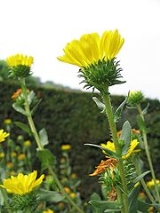
Grindelia camporum
Encyclopedia
Grindelia camporum is a species of flowering plant in the daisy family
known by the common names Great Valley gumplant and Great Valley gumweed. It is native to California
and Baja California
, where it can be found in a number of habitats. Its range may extend into Nevada
. This hardy plant readily grows in disturbed and altered areas such as ditches and roadsides. It is a gangly weedlike perennial topping two meters in maximum height. Its erect, branching stems are lined with many stiff, wavy-edged, serrated leaves 2 to 3 centimeters long. Atop the stem branches are inflorescence
s of a single large flower head
up to 3 centimeters wide. The head is a vaguely thistlelike cup of green clawlike phyllaries
that bend downward. The center of the head is filled with yellow disc florets and there are usually many yellow ray florets around the circumference. The flower head fills with a copious white exudate, especially during the early stages of blooming. This plant has a number of historical medicinal uses.
Asteraceae
The Asteraceae or Compositae , is an exceedingly large and widespread family of vascular plants. The group has more than 22,750 currently accepted species, spread across 1620 genera and 12 subfamilies...
known by the common names Great Valley gumplant and Great Valley gumweed. It is native to California
California
California is a state located on the West Coast of the United States. It is by far the most populous U.S. state, and the third-largest by land area...
and Baja California
Baja California
Baja California officially Estado Libre y Soberano de Baja California is one of the 31 states which, with the Federal District, comprise the 32 Federal Entities of Mexico. It is both the northernmost and westernmost state of Mexico. Before becoming a state in 1953, the area was known as the North...
, where it can be found in a number of habitats. Its range may extend into Nevada
Nevada
Nevada is a state in the western, mountain west, and southwestern regions of the United States. With an area of and a population of about 2.7 million, it is the 7th-largest and 35th-most populous state. Over two-thirds of Nevada's people live in the Las Vegas metropolitan area, which contains its...
. This hardy plant readily grows in disturbed and altered areas such as ditches and roadsides. It is a gangly weedlike perennial topping two meters in maximum height. Its erect, branching stems are lined with many stiff, wavy-edged, serrated leaves 2 to 3 centimeters long. Atop the stem branches are inflorescence
Inflorescence
An inflorescence is a group or cluster of flowers arranged on a stem that is composed of a main branch or a complicated arrangement of branches. Strictly, it is the part of the shoot of seed plants where flowers are formed and which is accordingly modified...
s of a single large flower head
Head (botany)
The capitulum is considered the most derived form of inflorescence. Flower heads found outside Asteraceae show lesser degrees of specialization....
up to 3 centimeters wide. The head is a vaguely thistlelike cup of green clawlike phyllaries
Bract
In botany, a bract is a modified or specialized leaf, especially one associated with a reproductive structure such as a flower, inflorescence axis, or cone scale. Bracts are often different from foliage leaves. They may be smaller, larger, or of a different color, shape, or texture...
that bend downward. The center of the head is filled with yellow disc florets and there are usually many yellow ray florets around the circumference. The flower head fills with a copious white exudate, especially during the early stages of blooming. This plant has a number of historical medicinal uses.

